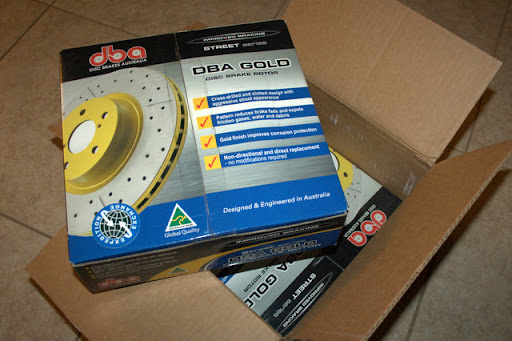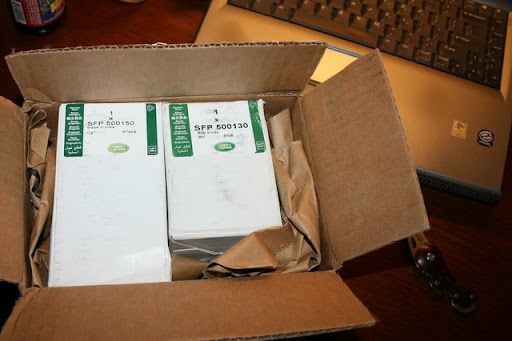Ahhh! the soothing screech of metal grinding on metal as you frantically pump the brake pedal during your approach to the crowded intersection. After 45,000 miles I decided that just maybe it was time for new brakes, not just pads but the whole shebang on all four corners of my 2001 Land Rover Discovery II.
Now, many early model DII owners have become accustomed to pumping the brake pedal, but this had gotten ridiculous. I did my research on OEM vs aftermarket and I thoroughly confused myself. I considered that Land Rover Genuine replacement brake rotors and pads tend to wear out faster than some of the aftermarket products. I also considered that I was replacing the vehicles second complete set of brakes which were EBC rotors with Ferodo pads.
Close to my wit’s end I decided to call Ho over at Expedition Exchange. He owns a DII and he has tried several combinations of different rotors and pads including LR Genuine and aftermarket. After a bit of discussion with Ho and some more research, I decided to use DBA rotors and Land Rover Genuine pads.


The rotors by Disc Brakes Australia are slotted, cross drilled and they have a special venting system built into the front rotors that they call Kangaroo Paw. Essentially the slots help eliminate the affects of off-gassing while the cross drilled holes work with the ventilation system to reduce the operating temperature of the rotor which helps to reduce brake fade.
http://www.dba.com.au/2006/videoclip.asp
Wait! Don’t get yourself started, I know this is often a debatable issue, the use of slotted and cross drilled brake rotors on anything other than a professional race car, right.
Well the way I see it is that the DII is a heavy vehicle to begin with, now add a winch bumper, winch, armor, expedition cargo and slightly oversized tires with increased rolling mass and the braking begins to build up some serious heat. In addition, the vented and cross drilled rotor system costs as much if not less than the genuine parts system so there is really no downside. Even if this choice costs the same as genuine parts it will most likely last longer and therefore prove to be less expensive. Any edge that can help defeat the “soft pedal” of early model DIIs is beneficial.
https://www.expeditionexchange.com/dba/
Best of all is that I have noticed a considerable improvement in braking performance. Some of this could be attributed to the fact that my previous brakes were life threatening, but I also remember what the previous system felt like when new and the DBAs with Genuine pads is no doubt better. I no longer have to pump the system as much, and rolling downhill onto three wheels feels much more comfortable and secure!
By the way, the soft pedal issue in early model DIIs is a brake caliper issue not rotors or pads. Aside from upgrading your early model DII calipers to 2004 models you can upgrade your combination of rotors and pads and install stainless steel brake lines which expand less than the OEM rubber lines.
Brian
Now, many early model DII owners have become accustomed to pumping the brake pedal, but this had gotten ridiculous. I did my research on OEM vs aftermarket and I thoroughly confused myself. I considered that Land Rover Genuine replacement brake rotors and pads tend to wear out faster than some of the aftermarket products. I also considered that I was replacing the vehicles second complete set of brakes which were EBC rotors with Ferodo pads.
Close to my wit’s end I decided to call Ho over at Expedition Exchange. He owns a DII and he has tried several combinations of different rotors and pads including LR Genuine and aftermarket. After a bit of discussion with Ho and some more research, I decided to use DBA rotors and Land Rover Genuine pads.

The rotors by Disc Brakes Australia are slotted, cross drilled and they have a special venting system built into the front rotors that they call Kangaroo Paw. Essentially the slots help eliminate the affects of off-gassing while the cross drilled holes work with the ventilation system to reduce the operating temperature of the rotor which helps to reduce brake fade.
http://www.dba.com.au/2006/videoclip.asp
Wait! Don’t get yourself started, I know this is often a debatable issue, the use of slotted and cross drilled brake rotors on anything other than a professional race car, right.
Well the way I see it is that the DII is a heavy vehicle to begin with, now add a winch bumper, winch, armor, expedition cargo and slightly oversized tires with increased rolling mass and the braking begins to build up some serious heat. In addition, the vented and cross drilled rotor system costs as much if not less than the genuine parts system so there is really no downside. Even if this choice costs the same as genuine parts it will most likely last longer and therefore prove to be less expensive. Any edge that can help defeat the “soft pedal” of early model DIIs is beneficial.
https://www.expeditionexchange.com/dba/
Best of all is that I have noticed a considerable improvement in braking performance. Some of this could be attributed to the fact that my previous brakes were life threatening, but I also remember what the previous system felt like when new and the DBAs with Genuine pads is no doubt better. I no longer have to pump the system as much, and rolling downhill onto three wheels feels much more comfortable and secure!
By the way, the soft pedal issue in early model DIIs is a brake caliper issue not rotors or pads. Aside from upgrading your early model DII calipers to 2004 models you can upgrade your combination of rotors and pads and install stainless steel brake lines which expand less than the OEM rubber lines.
Brian
